American composer Tom Myron was born November 15, 1959 in Troy, NY. His compositions have been commissioned and performed by the Kennedy Center, the United States Holocaust Memorial Museum, the Portland Symphony Orchestra, the Eclipse Chamber Orchestra, the Atlantic Classical Orchestra, the Eastern Connecticut Symphony Orchestra, the Topeka Symphony, the Yale Symphony Orchestra, the Civic Orchestra of Chicago, the Bangor Symphony and the Lamont Symphony at Denver University.
He works regularly as an arranger for the New York Pops at Carnegie Hall, writing for singers Rosanne Cash, Kelli O'Hara, Maxi Priest & Phil Stacey, the Young People's Chorus of New York City, the band Le Vent du Nord & others. His film scores include Wilderness & Spirit; A Mountain Called Katahdin and the upcoming Henry David Thoreau; Surveyor of the Soul, both from Films by Huey.
Individual soloists and chamber ensembles that regularly perform Myron's work include violinists Peter Sheppard-Skaerved, Elisabeth Adkins & Kara Eubanks, violist Tsuna Sakamoto, cellist David Darling, the Portland String Quartet, the DaPonte String Quartet and the Potomac String Quartet.
Tom Myron's Violin Concerto No. 2 has been featured twice on Performance Today. Tom Myron lives in Northampton, MA. His works are published by MMB Music Inc.
FREE DOWNLOADS of music by TOM MYRON
Symphony No. 2
Violin Concerto No. 2
Viola Concerto
The Soldier's Return (String Quartet No. 2)
Katahdin (Greatest Mountain)
Contact featuring David Darling
Mille Cherubini in Coro featuring Lee Velta
This Day featuring Andy Voelker
|
|
|
|
| 
Thursday, February 23, 2006
Music & Pictures
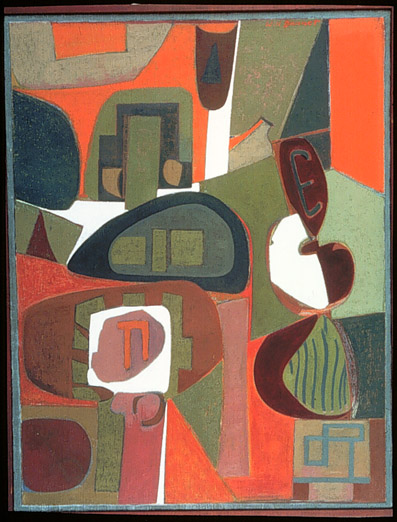
Will Barnet Landscape 1959-1960
Here is Rebecca Marchand's fine new program note for my Symphony #2. The symphony will be performed by Toshiyuki Shimada and the Portland Symphony Orchestra on April 23. To listen to the symphony click here. And here's a great 360-degree view of the hall!
Tom Myron's SYMPHONY NO. 2
By Rebecca Marchand
Tom Myron has said, "It has always struck me that the fastest way to sound like someone else is to copy their harmonic strategies." And while some of Myron's music reflects the more innocent "American" sound of Roy Harris and Aaron Copland, it is an artful display of convention without rhetoric, architecture without mechanism, and insight without ego. His music reflects a more eclectic America which encompasses musical influences from jazz, modernism and World Music as well as a range of visual arts, painting in particular.
Myron's Symphony No. 2 most potently displays the composer's connection to painting on both musical and personal levels. The symphony is dedicated to Elena and Will Barnet, the latter of whom is one of the great American painters of the postwar period and a close friend of Myron's.
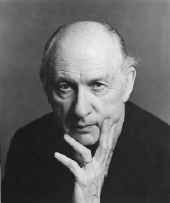
Will Barnet
The entire symphony balances lushness with a sense of open space that easily complements Barnet's visual style. The composer admits: "Because I can't be a painter as good as Will Barnet, I wanted to do something musically." Myron describes his approach to the symphony as "architectural", but also reveals a hidden, more personal program. One that also shares parallels with some of Barnet's artistic concerns:
"To be honest the piece for me is very tied up with the experience of becoming a parent. I started it when Vivian was about one year old and I was staying at home with her. If anything, the three movements should have the feel of really good children's book illustrations- beautiful, somewhat exaggerated, direct without being patronizing or condescending and "knowing" without being calculating."
Like the paintings of Barnet, the symphony captures moments that range from pensive and ethereal to vigorous and muscular in a language that is clear, concise and always lyrical. The first movement, marked "Graceful, poised" is a delightful mixture of wonder and whimsy. Beginning with a simple rising third motive announced by the brass, the movement grows out of that idea eventually revealing a dramatic theme which carries the movement in and out of pensive reflection. The thematic material is constructed of falling thirds and rising sevenths, revealing the architecture to which Myron refers.
The movement transitions into a more playful middle section which evokes a sense of "darn fool ditties", folk ballads and TV show themes of the 50s and 60s." Announced by a flute solo, the section becomes an homage to the best of the "Western" sound complete with offbeat punctuations in the brass and a recognizable tip of the hat to "Camptown Races". Although it is all originally composed thematic material, Myron draws on just enough rhetoric to easily stimulate the listener's imagination. This thematic potpourri culminates in a ringing celebration wherein the strings toll like bells underneath jubilantly frenzied winds. After a foray back to the opening themes, the movement concludes, breathlessly open and triumphant.
The symphony's middle movement provides a haunting contrast to the exuberance of the outer movements. A mysterious cello solo in E minor introduces a gentle rocking of thirds in the viola, which echo the falling thirds of the first movement. This movement, with its marking of "Vast, haunted" is meant to evoke the atmosphere of Barnet's 1960 painting Woman and the Sea.
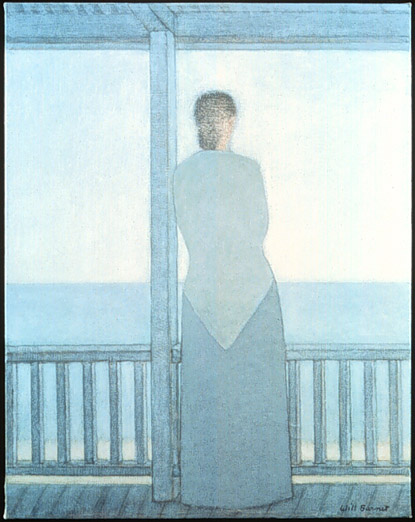
Will Barnet Woman and the Sea ca. 1960
In the painting, a woman stands on a porch with her back to the viewer, gently leaning against a post as she gazes out into a bluish field of water and sky. Although the light from the sky illuminates her figure, she shares the hues of her surroundings and therefore contributes to them rather than steals the focus from them. And this is an integral concept in Myron's compositional method. Although the third interval is absolutely central to the motivic coherence of the movement, the listener is more aware of a constant sense of the tide and the mysteries nestled within the lush texture. With an orchestral richness worthy of Vaughan Williams, the passage organically returns to the haunting first theme, underscored by a shimmering celesta, like light playing off the waves in the sea.

Will Barnet Blue Bicycle 1979
Myron reveals that the third movement is a "...documentary portrait of watching my daughter learn to walk and fall and generally come to terms with (and eventually master) gravity." Marked "Vivd, flying" he considers the movement to be a high-spirited musical cousin to Barnet's many paintings of his own daughter Ona. After the careening and syncopated "learning to walk" music a cantabile second theme is carried through several transitions, transformed into jaunty and playful skipping motives and, ultimately, into a mature and graceful Strauss-ian waltz. The movement recalls a flock of swallows, diving and turning-on-a-dime in high-speed unison. It brings the entire symphony to a soaring finale, conveying a keen sense of physical motion, the muscular euphoria of childhood.
posted by Tom Myron
Thursday, February 16, 2006
Someone To Watch Over Me
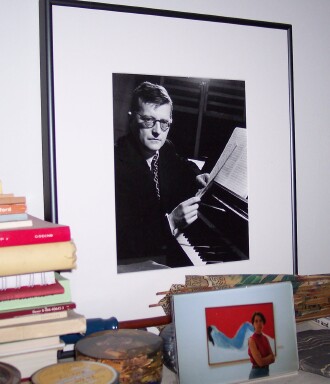
My friend rb has a post on her blog about the images of famous people that artists keep in their work spaces. Here's mine- it's a 1953 portrait of DSCH by Yevgeny Khaldei. It was printed by the photographer from the original negative in 1996. In person the affect of the image is arresting, almost three-dimensional. The music on the piano is an autograph of one of the string quartets. Because of the image's depth of field I can't quite make out which one, but 1953 was the year of Stalin's death- the year in which Shostakovich's first four quartets were heard for the first time.
posted by Tom Myron
Tuesday, February 14, 2006
Valentine's Day Baby
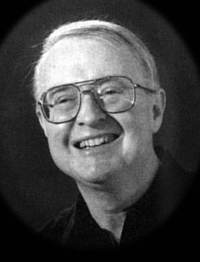
Happy Birthday Uncle Charles!
I hear the violoncello, ('tis the young man's heart's complaint,)
I hear the key'd cornet, it glides quickly in through my ears,
It shakes mad-sweet pangs through my belly and breast.
I hear the chorus and it is a grand opera,
Ah this indeed is music- this suits me.
Walt Whitman
Being Music
posted by Tom Myron
|
| |



